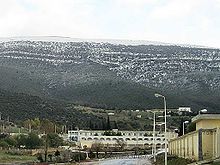Khenchela
Khenchela
خنشلة | ||
|---|---|---|
City | ||
| City of Khenchela | ||
ONS code 4001 | | |
| Climate | Csb | |
Khenchela ancient Mascula (
Geography
Climate
Located in the
This is one of the coldest cities in Algeria.

| Climate data for Khenchela | |||||||||||||
|---|---|---|---|---|---|---|---|---|---|---|---|---|---|
| Month | Jan | Feb | Mar | Apr | May | Jun | Jul | Aug | Sep | Oct | Nov | Dec | Year |
| Mean daily maximum °C (°F) | 9.0 (48.2) |
10.6 (51.1) |
13.9 (57.0) |
17.6 (63.7) |
21.2 (70.2) |
26.6 (79.9) |
30.1 (86.2) |
29.4 (84.9) |
25.7 (78.3) |
19.7 (67.5) |
14.5 (58.1) |
10.2 (50.4) |
19.0 (66.3) |
| Mean daily minimum °C (°F) | −0.5 (31.1) |
0.4 (32.7) |
2.0 (35.6) |
4.1 (39.4) |
7.0 (44.6) |
11.1 (52.0) |
13.1 (55.6) |
13.1 (55.6) |
11.7 (53.1) |
7.8 (46.0) |
4.1 (39.4) |
0.7 (33.3) |
6.2 (43.2) |
| Average precipitation mm (inches) | 43 (1.7) |
44 (1.7) |
63 (2.5) |
40 (1.6) |
49 (1.9) |
25 (1.0) |
12 (0.5) |
17 (0.7) |
32 (1.3) |
37 (1.5) |
46 (1.8) |
38 (1.5) |
446 (17.7) |
| Source: Climate-data.org[1] | |||||||||||||
History

The French army reached Khenchela in 1850 after heavy fighting and more strenuous resistance and set up a military administration. Organization of work of the city were undertaken. The first French settlers were allowed from 1878. Farms were built and they made plantations. In doing so, the farmers cleared a path for vegetation at the valley of Wadi Boughegal which in turn gave birth to natural grasslands, allowing cattle breeding and feeding the population with fresh dairy products (i.e. milk, butter, cheese).
In October 1905, the inauguration of the line of Railway Ain Beida in Khenchela meter gauge will provide a daily service with the North. Military administration lasted until 1912.
In 1982, a mass grave containing more than 1200 corpses from the
Since then, the population has grown particularly fast: 12 000 inhabitants in 1954, 28,000 in 1962, 70,000 in 1987 and 87,196 in 2002. This increase is partly explained by population displacement during the war in Algeria, the area being a refuge for resistance fighters. This has posed and continues to pose planning problems (housing, water, sewer, electricity).


